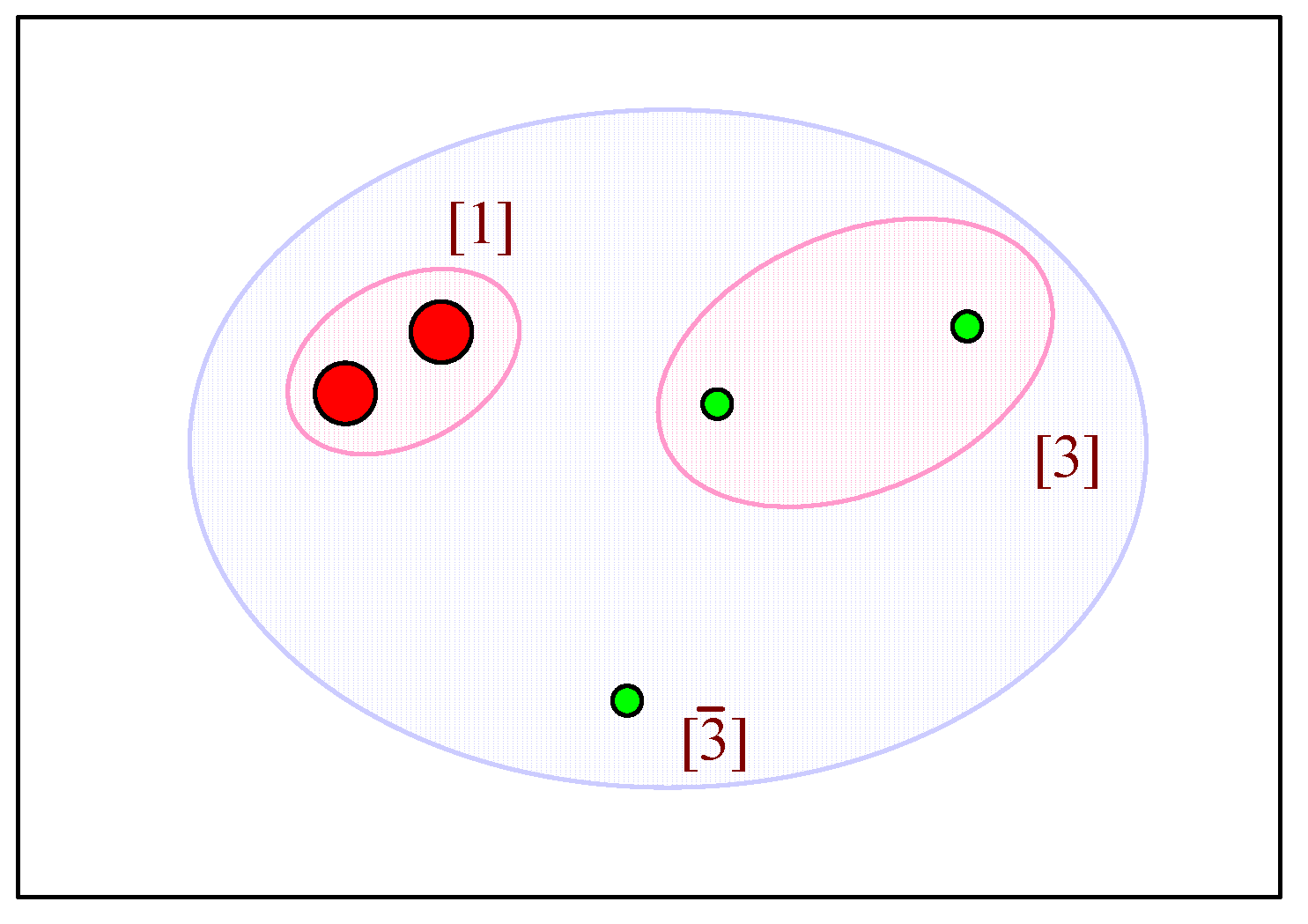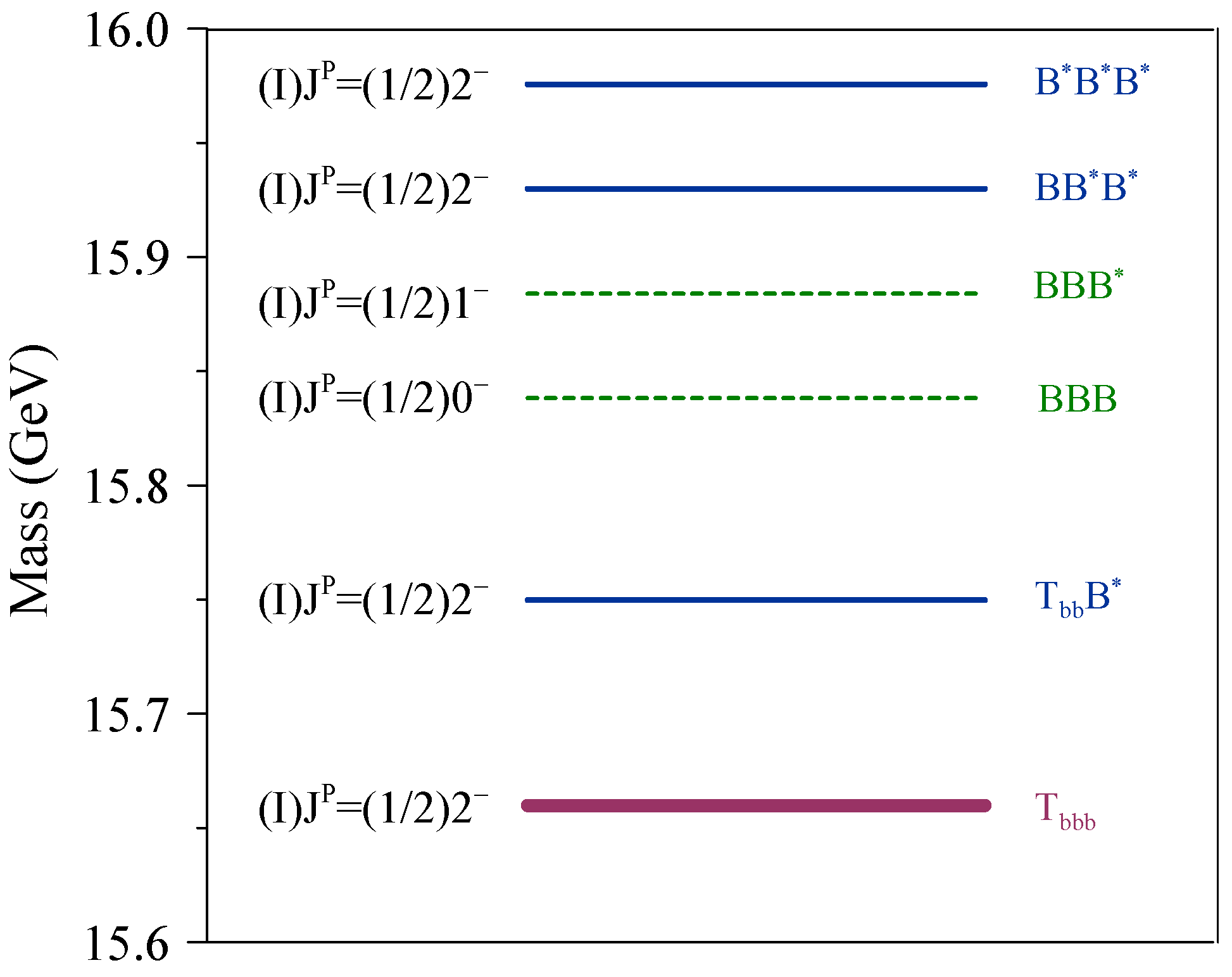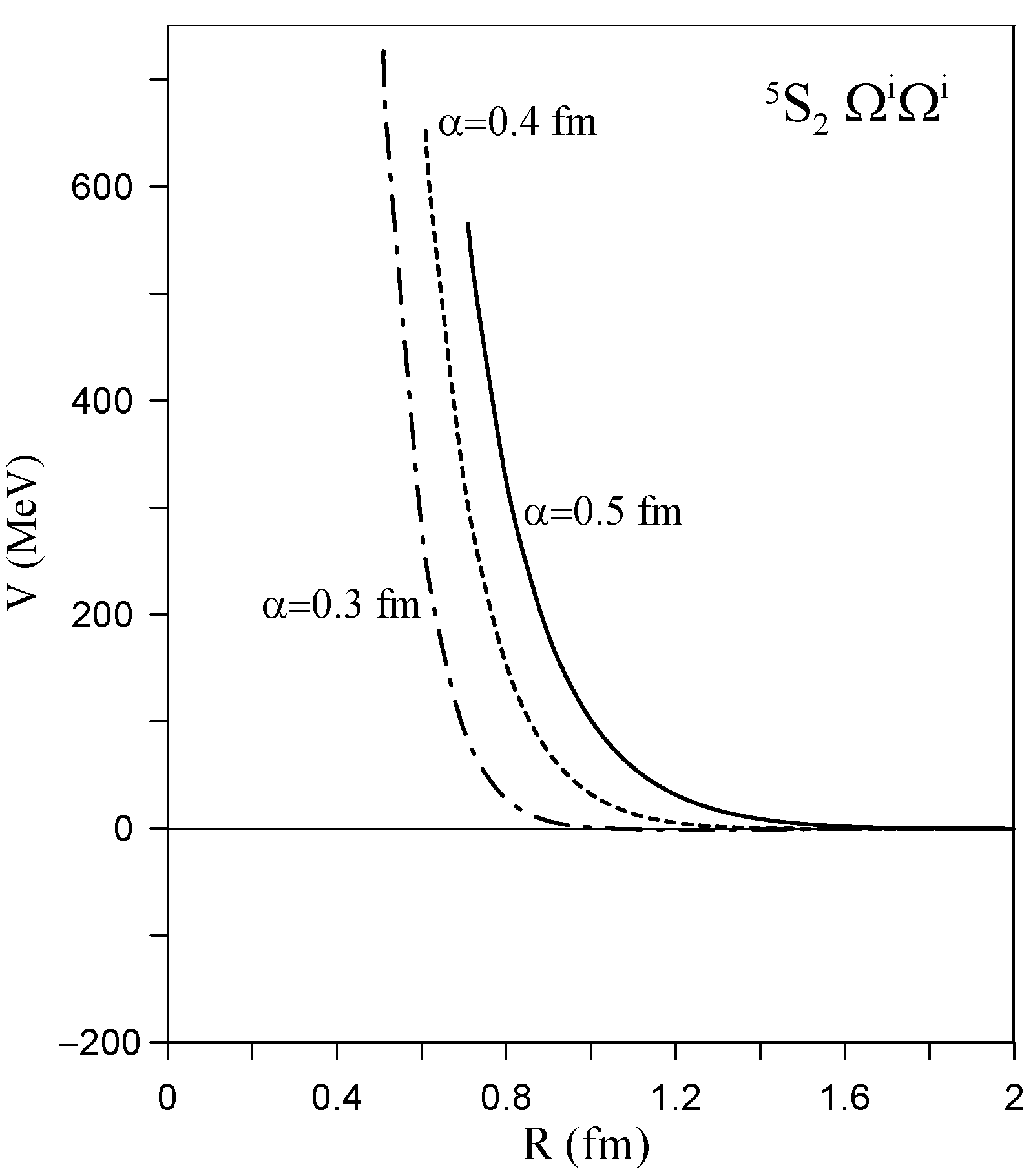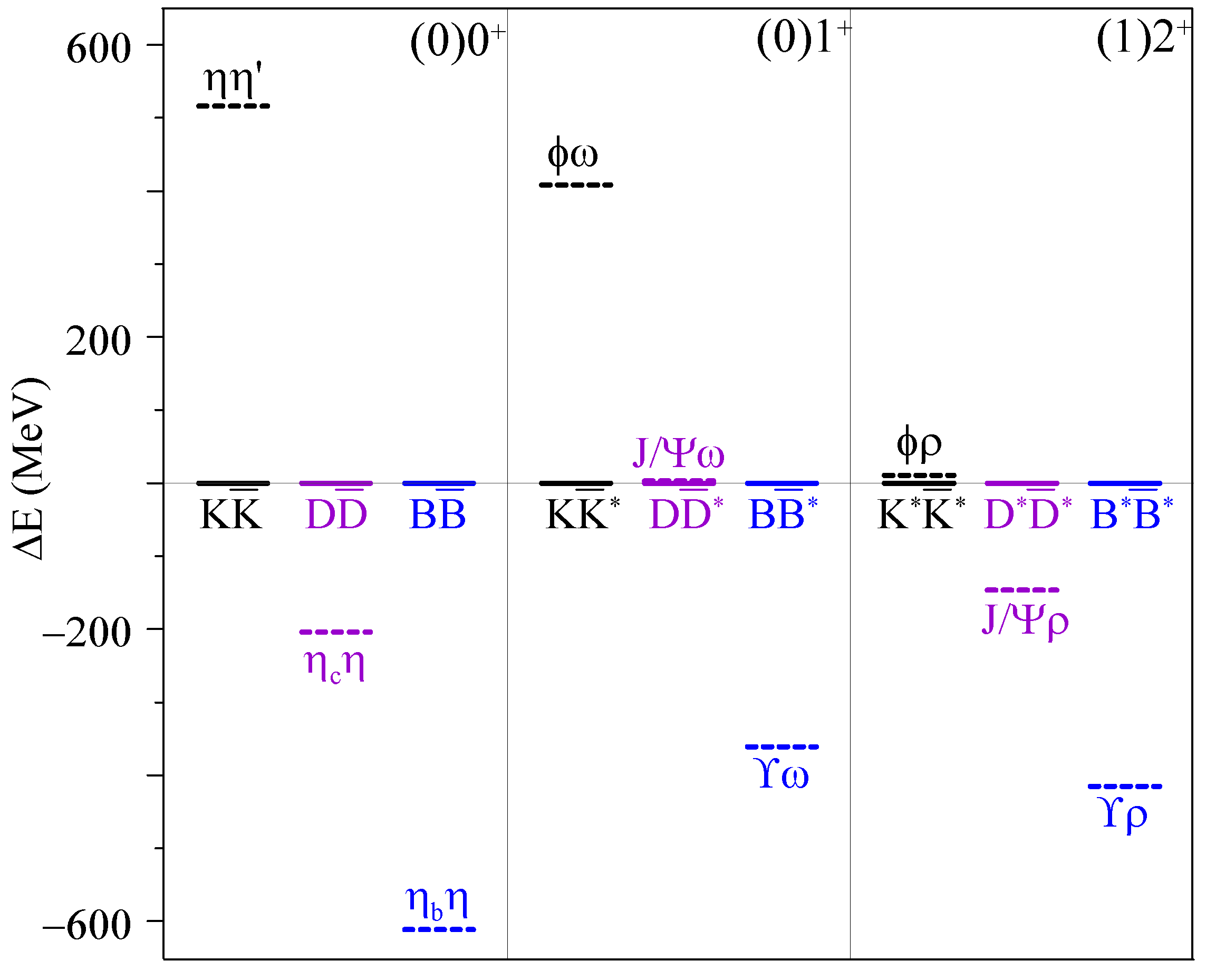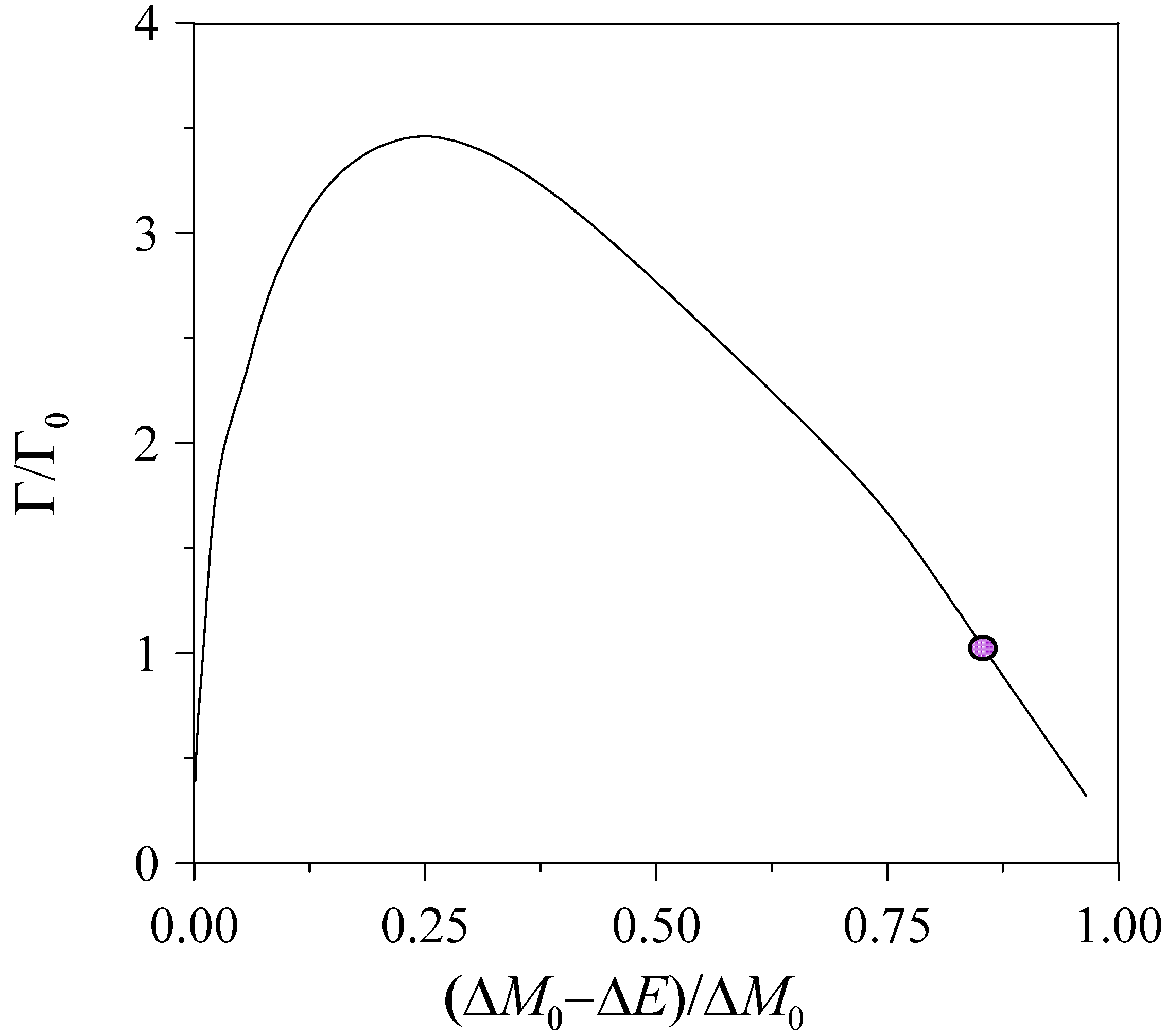2.1. Coulomb-like Color Correlations
As noted earlier, a central theoretical challenge in the study of multiquarks is identifying multiquark hadrons that do not promptly decay through their fall-apart channel into lighter hadrons. This challenge has motivated proposals emphasizing internal correlations, dynamical mechanisms that constrain the allowed quantum numbers of subsystems, thereby enhancing stability. Notable among these are diquark models [
55,
56], which restrict the color degree of freedom of quark pairs to specific configurations.
Various diquark models exist, but all impose constraints on the color states of quark–quark or quark–antiquark pairs. For example, some models require diquarks to be in a color
state [
57,
58,
59,
60], while others focus on quark–antiquark pairs restricted to a color
[
61]. If a multiquark contains color structures not found in asymptotic hadron states, this could act as a stabilizing mechanism, enhancing the possibility of bound-state formation. Compared to uncorrelated models, these approaches generally predict a richer spectrum of exotic hadrons.
We have employed dynamical correlations induced by the Coulomb-like short-range color interaction between heavy quarks to study hidden-flavor pentaquarks of the form
, where
or
c,
or
d, and
[
35,
36]. While traditional diquark models often emphasize attractive
interactions in a color-
state, we argue that the
color singlet is even more favorable due to binding energy scaling with the heavy quark mass
. In natural units, the binding energy of a
diquark scales with the light quark mass
, whereas that of the color-singlet
pair scales as
. This favors an internal structure dominated by a color-singlet
pair rather than a color-octet [
15], as illustrated in
Figure 1. Taking into account the isospin-zero nature of the heavy quarks and the antisymmetry of the color-
wave function (which enforces matching spin and isospin), we construct the wave function for the lowest-lying states, that is, those with a fully symmetric radial wave function, of any
pentaquark:
where
and
denote the the isospin and spin of the different components.
for
and
for
. The Coulomb-like correlations between the heavy quarks help to avoid repulsive interactions associated with color-octet
configurations. Notably, these constraints also arise naturally in constituent quark models for doubly heavy tetraquarks [
62,
63].
QCD favors certain quark configurations over others [
15]. As discussed above, the strongest quark–antiquark correlation occurs in the color-, flavor-, and spin-singlet channel
. The next most favorable configuration is the color-antitriplet, flavor-antisymmetric, spin-singlet channel
, which underlies the structure of diquarks.
Table 2 lists hidden-flavor pentaquark states containing at least one such favorable QCD channel, i.e., a spin-zero diquark.
To analyze the effects of Coulomb-like correlations on the structure of hidden-flavor pentaquarks, we employ the generic constituent quark model known as the AL1 potential [
64]. This model has been widely used in studies of multiquark systems [
33,
34,
62,
65,
66,
67,
68]. It features a central potential combining a Coulomb term with a linear confinement term, complemented by a smeared chromomagnetic spin–spin interaction:
The model parameters are set as follows: , , , , , and . The constituent quark masses are as follows: , , , and . The color factor is adapted to differentiate between quark–quark and quark–antiquark interactions.
Notably, the smearing of the spin–spin interaction depends on the reduced mass of the interacting quark pair, thereby maintaining the flavor dependence of the interaction. The AL1 potential parameters were finely tuned through a global fit to 36 mesons and 53 baryons, achieving excellent agreement with experimental data, as detailed in Table 2 of Ref. [
64]. Although the reported
value is slightly higher than that of some other models, this is largely due to the inclusion of high-angular-momentum resonances. Nevertheless, the AL1 model remains highly effective for analyzing low-energy hadron spectra [
69]. The color–spin algebra pertinent to five-quark systems has been systematically developed in Refs. [
66,
70].
In multiquark dynamics, binding can arise either from medium- to long-range attraction, often modeled through Goldstone boson exchange between color-singlet clusters [
71,
72,
73], or from short-range dynamics driven by one-gluon exchange. While the latter typically generates strong repulsion in nucleon–nucleon (
)
S-waves, it does not universally apply to all hadronic channels. For example, certain configurations in the
and
sectors display short-range attraction, as evidenced by their low-energy phase shifts [
74]. This attraction has underpinned predictions of resonances in these systems [
75,
76,
77,
78], some of which may have experimental support [
8]. For a detail discussion on the interplay between Goldstone boson and one-gluon exchange mechanisms within hybrid constituent models, particularly regarding tetraquark stability, see Refs. [
71,
79].
2.3. Results and Discussion
We solved the three-body problem for various
configurations of the
pentaquark systems discussed in
Section 2.1. The resulting binding energies for the different hidden-flavor pentaquark configurations are summarized in
Table 4.
We first observe an apparent degeneracy between the
and
vectors. These correspond to
and
pentaquarks with
, and to
and
states with
. This behavior aligns with the isospin-independent character of the interaction model described in Equation (
2). Nevertheless, this degeneracy is nontrivial because of the constraints imposed by the Pauli principle.
The dominant quark correlations governed by QCD dynamics, as summarized in
Table 2, allow us to infer general features of the multiquark spectrum. The mass splitting between the spin-triplet and spin-singlet
configurations corresponds to the
mass difference in the charmonium sector and the
difference in the bottomonium sector. Additionally, the mass splitting between spin-triplet and spin-singlet
diquarks, with color–flavor configurations
and
, respectively, has been estimated from lattice QCD simulations to lie between 100 and 200 MeV [
85,
86,
87]. Based on these findings, we adopt the following effective values for these mass differences:
Thus, the mass of a
pentaquark state can be written as
where
is the binding energy given in
Table 4 and
denotes the sum of the masses of a spin-zero
pair, a spin-zero
diquark, and a light quark. A similar expression holds for the
states, where the light quark is replaced by a strange quark, and the corresponding mass term is denoted
:
Using
MeV, we compute the predicted masses listed in
Table 5. The recent observation of a hidden-charm pentaquark with strangeness [
51] allows for the calibration of the free parameter in the strange sector. Adopting
MeV, we obtain the results shown in
Table 6. For completeness,
Table 7 presents a comparison of our predictions with those from other theoretical approaches.
We are now in a position to make parameter-free predictions for the lowest-lying nonstrange and strange hidden-bottom pentaquarks, for which no experimental observations currently exist. These predictions are presented in
Table 8 and
Table 9, alongside results from other theoretical frameworks. Together, they provide a consistent set of spin-parity assignments for the lightest hidden-flavor pentaquark states and serve as useful benchmarks for future experimental investigations, particularly in the hidden-bottom sector.
The spin-parity quantum numbers of hidden-flavor pentaquarks remain experimentally undetermined [
27]. Nevertheless, a range of theoretical models offer predictions that can be confronted with our results summarized in
Table 5,
Table 6,
Table 7,
Table 8 and
Table 9. We begin our discussion with the hidden-charm sector for subsequent analysis of the remaining systems.
Although the quantum numbers of the
remain uncertain [
93], the majority of theoretical works favor a
assignment [
94,
95,
96,
97,
98,
99]. The two narrow overlapping structures
and
[
50] were initially interpreted as a single resonance,
[
49]. Before the experimental resolution of this doublet, theoretical models had already predicted the existence of two nearly degenerate states with quantum numbers
and
in this mass region. These states were interpreted either as hidden-charm pentaquarks dynamically generated through
interactions [
94,
98,
100] or as bound states of charmonium
and the nucleon [
101]. In both scenarios, the predicted quantum numbers are consistent with our findings.
Our model also predicts two candidate states corresponding to the broad
resonance: one with
and another with
. The true nature of this state remains uncertain and represents a significant challenge for future experimental investigations [
102]. While earlier studies proposed various spin assignments, ranging from
to
[
49], a more recent analysis of
decays favors a
assignment [
103]. Based on this evidence, we tentatively associate the
with the
state predicted by our model. This identification naturally suggests the existence of a nearby
partner state, with an estimated mass around 4390 MeV. It is worth noting that for strange hidden-charm pentaquarks, our results are in good agreement with the recent experimental measurement by Belle [
54], which reports a mass of
MeV/c
2 for the
. Our model predicts a mass 4474 MeV/c
2 for the
state. This consistency is particularly encouraging.
Ref. [
72] investigates hidden-charm pentaquarks within the framework of a quark delocalization color screening model. The most deeply bound configurations, corresponding to
and
, are dominated by a
structure, reflecting strong short-range Coulomb-like correlations between the heavy quarks. In contrast, configurations of the form
result only in quasi-bound states. Ref. [
73] investigates hidden-charm pentaquarks within a chiral quark model. In contrast to Ref. [
72], the dominant configuration found here is
. This difference may be attributed to the absence of shared light quarks between the quarkonium and baryon components in the
configuration, which suppresses meson exchanges due to the Okubo–Zweig–Iizuka (OZI) rule [
104]. This rationale also underlies the tendency of hadronic molecular models to describe hidden-flavor pentaquarks as bound states of open-flavor hadrons [
19,
24,
105,
106,
107,
108]. In such models,
D-meson exchange is too short-ranged to effectively compete with the medium-range attraction generated by light-meson exchanges, which is more naturally realized in the
configuration. Consequently, hybrid and purely gluonic models tend to yield different multiquark spectra. Several studies also predict the existence of
pentaquarks. Within the hadroquarkonium framework, Ref. [
109] provides robust predictions of isospin-3/2
bound states near 4.5 GeV. From the constituent quark model perspective, Ref. [
66] similarly supports the existence of
hidden-flavor pentaquarks, including a
state located close to threshold. Ref. [
61] explores compact hidden-flavor pentaquarks constructed from the repulsive color-octet–octet configuration
. In this framework, negative-parity states are predicted to remain bound only with respect to the heavier
threshold. A distinctive feature of this model is the strong suppression of branching ratios into hidden-flavor channels, which serves to differentiate compact color-octet pentaquarks from meson–baryon molecular states. Ref. [
110] employs an extended chromomagnetic model that augments the conventional color–spin interaction with effective quark-pair mass parameters, fitted to reproduce known meson and baryon spectra. The
spectrum, as presented in Figure 1 of Ref. [
110], aligns well with our findings. However, it does not reproduce the near-degeneracy between
and
states observed in our model, likely a consequence of the method used to extract the effective parameters, since the underlying interaction is isospin independent.
Beyond constituent quark models, a variety of other theoretical frameworks have been employed to study hidden-flavor pentaquarks. Predictions from diquark-based models exhibit significant variation, largely depending on the assumptions made regarding diquark dynamics [
57,
58,
59,
60,
111]. QCD sum rule approaches also lead to diverse outcomes, predicting both molecular-like states [
112,
113,
114,
115] and hidden-color configurations [
116]. For a thorough overview of recent progress in QCD sum rule techniques and their relevance to exotic hadrons, see Ref. [
117]. Hadronic molecular models based on effective chiral Lagrangians or one-boson exchange potentials depend on low-energy constants and couplings that are often poorly known. These parameters are typically estimated using quark model relations [
94,
118,
119,
120,
121].
For the hidden-bottom pentaquarks listed in
Table 8, only theoretical predictions are available for comparison. Ref. [
61] employs a color-magnetic interaction model, estimating mass splittings relative to a reference mass fitted to experimental data. Ref. [
91] uses a chiral quark model and solves the five-body bound-state problem via the Gaussian expansion method. We cite results from the color-singlet calculation, which is theoretically closest to our framework, and list in parentheses those from the coupled-channel calculation that includes hidden-color configurations. Ref. [
92] provides predictions from a hadroquarkonium model for isospin-
baryons, considering two scenarios with different chromoelectric polarizabilities. We report the results corresponding to the weaker interaction strength, in which hidden-bottom pentaquarks appear in the 10.6–10.9 GeV range. The alternative model, based on a purely Coulombic treatment of charmonia, predicts more deeply bound states in the 10.4–10.7 GeV range. In this case, positive-parity states are less bound and lie approximately 150 MeV above their negative-parity counterparts. It is noteworthy that quark-based approaches [
61,
91] place hidden-bottom pentaquarks in the 11.0–11.2 GeV mass range, whereas the hadroquarkonium model [
92] predicts more deeply bound states.
In the strange hidden-charm sector, the perturbative color-magnetic model of Ref. [
61] predicts large mass splittings among the lowest-lying states. In contrast, the chiral effective field theory potentials of Ref. [
88] produce results more consistent with ours, locating the lowest states in the 4.3–4.4 GeV region. Notable, these authors find no bound states in
channels. Ref. [
89] employs a chiral quark model combined with a variational method, expanding radial wave functions in Gaussian bases. This approach, which has proven effective in describing nonstrange pentaquarks, predicts small binding energies across various baryon–meson channels. A complementary study of
tetraquarks within a similar chiral quark framework, utilizing the Gaussian expansion approach in combination with the complex-scaling technique, is presented in Ref. [
122]. By contrast, the hadroquarkonium model of Ref. [
90] predicts higher masses for strange hidden-charm pentaquarks while yielding lower masses than quark-based models for nonstrange and strange hidden-bottom systems.
The predicted strange hidden-bottom pentaquark states lie close in mass to their nonstrange counterparts, within the 11.1–11.3 GeV range. This aligns with the perturbative chromomagnetic model of Ref. [
61]. As in the nonstrange sector, the hadroquarkonium model of Ref. [
90] predicts significantly lower masses, with the most deeply bound states appearing near 10.4 GeV under the strong-attraction scenario. Consequently, hidden-bottom pentaquarks, both strange and nonstrange, offer a valuable testing ground for distinguishing between different multiquark interaction mechanisms. In particular, models based on quark substructure suggest that experimental searches should concentrate around the 11 GeV region.
Alternative theoretical frameworks have also been employed to study both strange and nonstrange hidden-flavor pentaquarks. One such approach is the diquark–triquark model of Ref. [
93], which leverages attractive color configurations involving non-pointlike triquarks and uses a light-cone distribution amplitude to describe the internal structure of the pentaquark. The model incorporates an effective Hamiltonian with spin–orbit interactions and predicts, among other states, the
as a
resonance with a mass of 4349 MeV and the originally reported
[
35] as a
state with a mass of 4453 MeV. The lightest predicted state is a
hidden-charm pentaquark at 4085 MeV. Although the model discusses
, their masses are not explicitly provided. Extending this framework, the same authors also explore strange hidden-charm and hidden-bottom pentaquarks. The lightest states in each sector for each spin-parity assignment are
Preliminary analyses of experimental data in the hidden-charm sector suggest the coexistence of both negative- and positive-parity states within the same energy region [
49]. We calculated the mass of the lowest positive-parity state, which corresponds to two nearly degenerate configurations with quantum numbers
and
. This excitation arises from the most strongly correlated internal structure, featuring a
pair in the color–flavor–spin configuration
, and a
subsystem in
. The lightest positive-parity hidden-charm pentaquark states are found above 4.5 GeV, specifically 4527 MeV for
and 4552 MeV for
. In contrast, excitation energies in the hidden-bottom sector are significantly lower, resulting in positive-parity states that lie closer in mass to their negative-parity ground-state counterparts: 11,273 MeV for
and 11,291 MeV for
. Nearly degenerate opposite-parity states may originate from distinct internal mechanisms, for example, a negative-parity state formed by coupling a radially excited quarkonium to a nucleon versus a positive-parity state generated through orbital excitation of a ground-state quarkonium–nucleon system [
101]. This pattern of parity assignments is also consistent with the Born–Oppenheimer interpretation proposed in Ref. [
58].
The decay properties of multiquark states are highly sensitive to their internal structure [
61]. Transitions into heavy meson–heavy baryon channels are generally expected to be strongly suppressed, primarily due to the need for heavy meson exchange in
t-channel processes. Given their quark composition, these exotic states may decay in a manner analogous to excited quarkonia such as
,
,
, or
. As a result, configurations containing a spin-zero
pair (e.g.,
,
,
in
Table 2) are predicted to exhibit narrower decay widths than those containing a spin-one
pair (such as
,
). This pattern is consistent with current empirical findings (see
Table 1). Nonetheless, the total decay width also depends critically on the internal structure of the bound state [
47,
48], a topic discussed in detail in
Section 4.
It should be emphasized that the correlation mechanisms employed in our framework do not universally guarantee the stability of multiquark systems across all flavor configurations. Just as the short-range repulsion in the nucleon–nucleon interaction, originating from one-gluon exchange, is not a general feature of all hadronic systems, our QCD-based model does not impose constraints on the color configurations of pentaquarks containing an anticharm or antibottom quark, such as
. As discussed in Ref. [
123], these states are unlikely to be bound due to the competing effects of chromoelectric and chromomagnetic interactions, which tend to disfavor binding in such configurations.
Our findings also contribute to the ongoing discussion regarding the possibility of charmonium forming bound states with atomic nuclei, a scenario originally proposed by Brodsky [
104]. Since charmonium contains no valence
u and
d quarks, its interaction with nucleons via light meson exchange is suppressed by the OZI rule. This limitation has led to the development of alternative models to generate sufficient attraction, including those based on chromoelectric polarizability and the energy–momentum tensor distributions of the nucleon [
101,
109,
124]. Additional support comes from studies of in-medium modifications of hadronic structure, such as the predicted formation of
-nucleus bound states [
125], and similar theoretical expectations for
-nucleus systems across various nuclear targets [
126]. Our approach introduces a distinct mechanism, driven by short-range one-gluon exchange between the charmonium and the constituent quarks of the nucleon. This mechanism, originally proposed in the context of dibaryon resonances [
74,
75,
76,
77,
78], represents, to our knowledge, the first derivation of such bound-state behavior solely from quark–gluon dynamics within a truncated Hilbert space.
